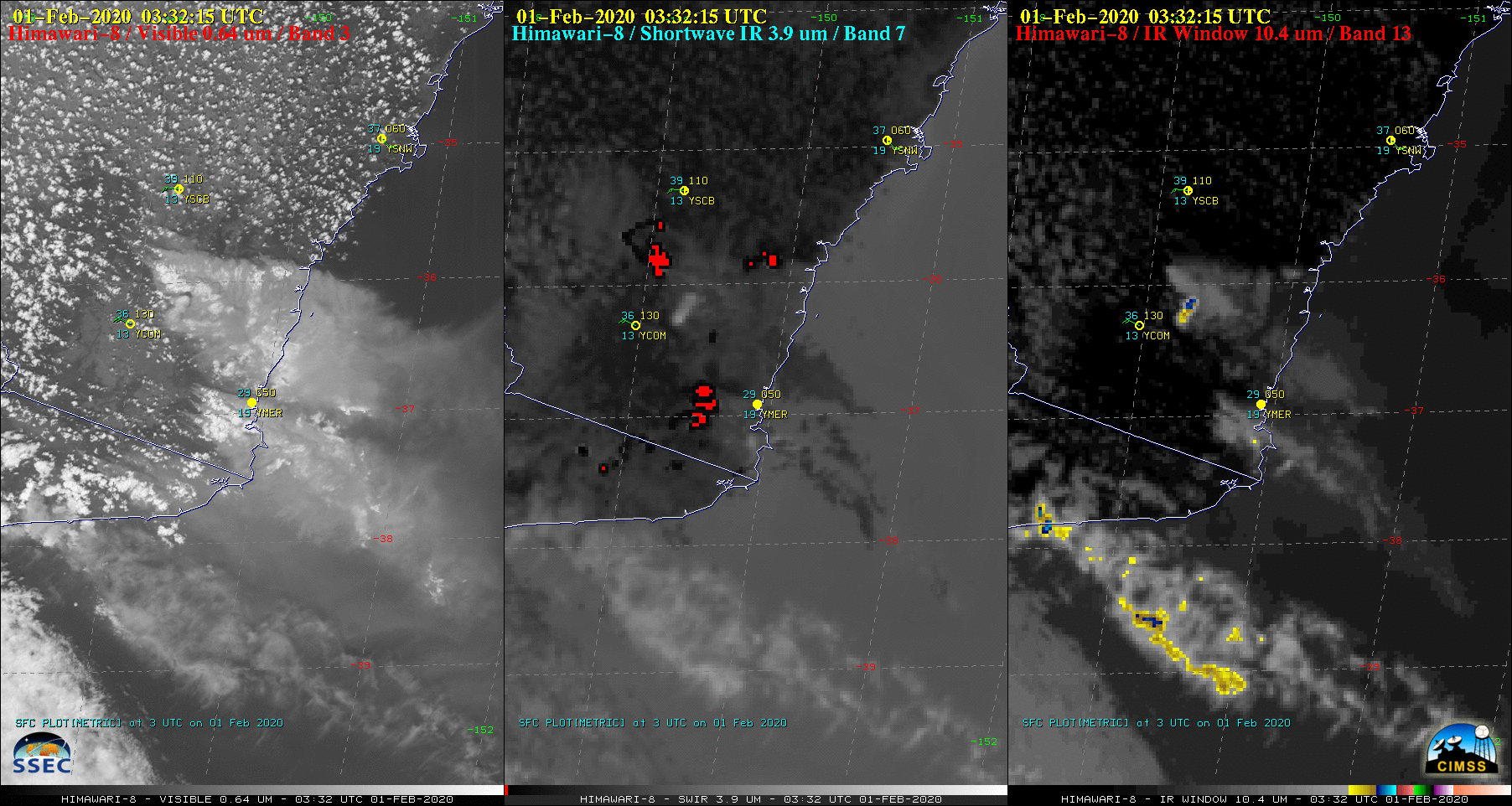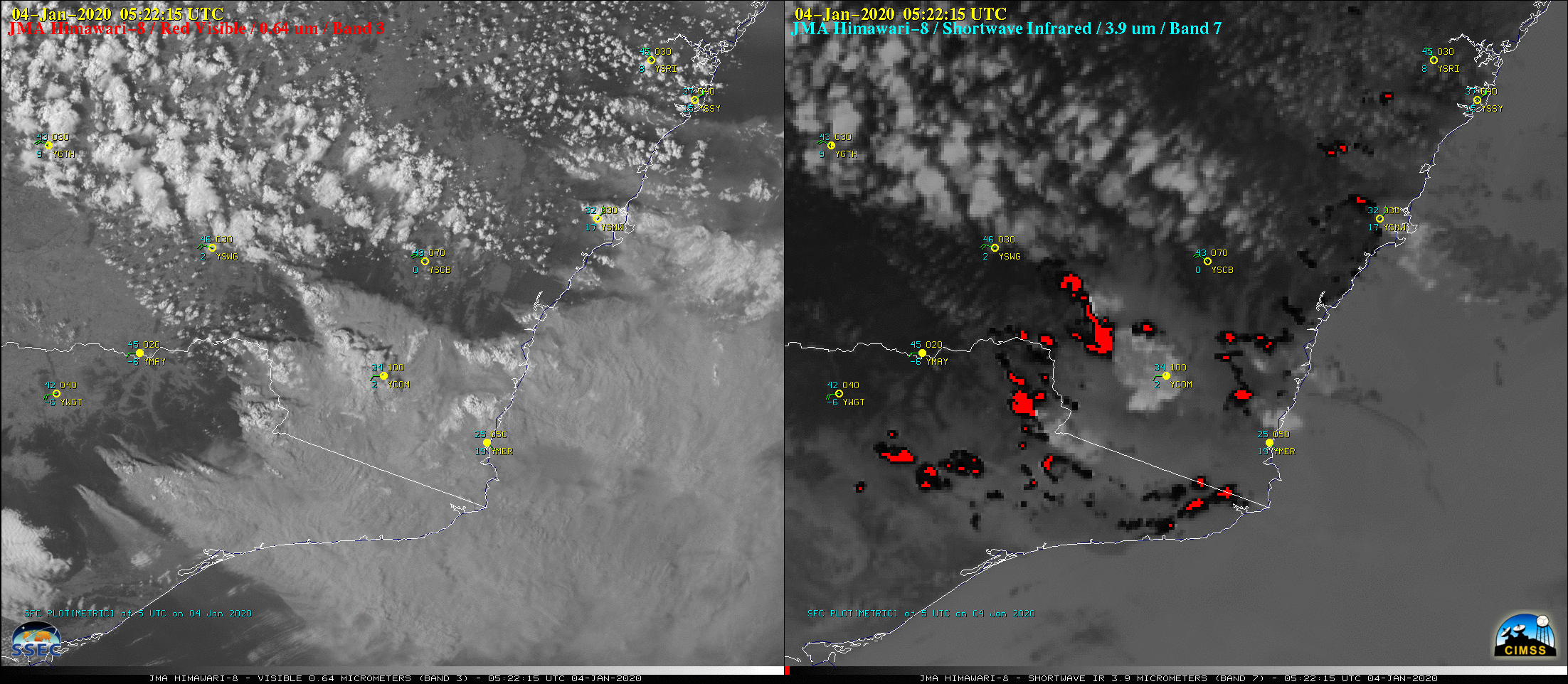![Himawari-8 Shortwave Infrared (3.9 µm, top) and Longwave Infrared Window (10.4 µm, bottom) images [click to play animation | MP4]](https://cimss.ssec.wisc.edu/satellite-blog/images/2019/12/HIM08_SWIR_IR_AUSTRALIA_PYROCB_29DEC2019_B713_2019363_165000_0002PANELS_FRAME00065.GIF)
Himawari-8 Shortwave Infrared (3.9 µm, top) and Longwave Infrared Window (10.4 µm, bottom) images [click to play animation | MP4]
The coldest cloud-top 10.4 µm infrared brightness temperature was -62.6ºC (darker green pixels) at 1650 UTC. According to rawinsonde data from Melbourne (below), this corresponded to an altitude near 13 km.
![Plots of rawinsonde data from Melbourne, Australia [click to enlarge]](https://cimss.ssec.wisc.edu/satellite-blog/images/2019/12/191229_YMML_RAOBS.GIF)
Plots of rawinsonde data from Melbourne, Australia [click to enlarge]
![w (11.45 µm) images from NOAA-20 and Suomi NPP [click to enlarge]](https://cimss.ssec.wisc.edu/satellite-blog/images/2019/12/191229_noaa20_suomiNPP_viirs_infrared_Australia_pyroCb_anim.gif)
VIIRS Infrared Window (11.45 µm) images from NOAA-20 and Suomi NPP [click to enlarge]
===== 30 December Update =====
![Himawari-8 Shortwave Infrared (3.9 µm, top) and Longwave Infrared Window (10.4 µm, bottom) images [click to play animation | MP4]](https://cimss.ssec.wisc.edu/satellite-blog/images/2019/12/HIM08_SWIR_IR_TARGET_AUSTRALIA_PYROCB_29_30DEC2019_B713_2019364_030215_0002PANELS_FRAME00093.GIF)
Himawari-8 Shortwave Infrared (3.9 µm, top) and Longwave Infrared Window (10.4 µm, bottom) images [click to play animation | MP4]
The coldest Himawari-8 cloud-top 10.4 µm brightness temperature was -73.15ºC at 13:24:41 UTC (violet pixel near the coast); this was 5ºC colder than the coldest temperature of -68.1ºC — at an altitude of 15 km — on 12 UTC rawinsonde data from Melbourne (below). During the 12-hour period between the 2 soundings, the coded tropopause ascended from a height of 13.1 km (-63.7ºC) at 00 UTC to 14.2 km (-67.5ºC) at 12 UTC.
![Plots of rawinsonde data from Melbourne, Australia at 00 UTC (yellow) and 12 UTC (cyan) [click to enlarge]](https://cimss.ssec.wisc.edu/satellite-blog/images/2019/12/191230_00UTC_12UTC_YMML_RAOBS.GIF)
Plots of rawinsonde data from Melbourne, Australia at 00 UTC (yellow) and 12 UTC (cyan) [click to enlarge]
![VIIRS Infrared Window (11.45 µm) images from NOAA-20 and Suomi NPP [click to enlarge]](https://cimss.ssec.wisc.edu/satellite-blog/images/2019/12/191230_14utc_noaa20_15utc_suomiNPP_viirs_infrared_Australia_pyroCb_anim.gif)
VIIRS Infrared Window (11.45 µm) images from NOAA-20 and Suomi NPP [click to enlarge]
===== 31 December Update =====
![Suomi NPP VIIRS Day/Night Band, Shortwave Infrared, Near-Infrared & Active Fire Product images at 1455 UTC on 31 December (credit: William Straka, CIMSS) [click to enlarge]](https://cimss.ssec.wisc.edu/satellite-blog/images/2019/12/191231_1455utc_suomiNPP_viirs_dayNightBand_shortwaveInfrared_nearInfrared_activeFireProduct_Australia_anim.gif)
Suomi NPP VIIRS Day/Night Band (0.7 µm), Shortwave Infrared (3.75 µm and 4.05 µm), Near-Infrared (1.61 µm and 2.25 µm) & Active Fire Product images at 1455 UTC on 31 December (credit: William Straka, CIMSS) [click to enlarge]
A sequence of daily Aqua MODIS True Color RGB images with an overlay of VIIRS Fire Radiative Power showed the fires and smoke during the 29-31 December period (below).
![Aqua MODIS True Color RGB images with an overlay of VIIRS Fire Radiative Power [click to enlarge]](https://cimss.ssec.wisc.edu/satellite-blog/images/2019/12/191229_191231_aqua_modis_trueColorRGB_viirs_fireRadiativePower_Australia_anim.gif)
Aqua MODIS True Color RGB images with an overlay of VIIRS Fire Radiative Power [click to enlarge]
A multi-day Himawari-8 GeoColor animation covering the period 28 December – 01 January is available here.


![NOAA-20 VIIRS True Color RGB and Infrared Window (11.45 µm) images at 042 UTC [click to enlarge]](https://cimss.ssec.wisc.edu/satellite-blog/images/2020/02/200201_0426utc_noaa20_viirs_trueColorRGB_infraredWindow_Australia_pyrocb_anim.gif)
![Suomi NPP VIIRS Day/Night Band (0.7 µm) and Shortwave Infrared (3.74 µm) images at 1454 UTC [click to enlarge]](https://cimss.ssec.wisc.edu/satellite-blog/images/2020/02/200201_1454utc_suomiNPP_viirs_dayNightBand_shortwaveInfrared_Australia_bushfires_anim.gif)

![Himawari-8 Shortwave Infrared (3.9 µm, top) and "Clean" Infrared Window (10.4 µm, bottom) images [click to play animation | MP4]](https://cimss.ssec.wisc.edu/satellite-blog/images/2020/01/HIM08_SWIR_IR_TARGET_AUSTRALIA_PYROCB_04JAN2020_B713_2020004_090215_0002PANELS_FRAME00269.GIF)
![Himawari-8 Shortwave Infrared (3.9 µm, top) and "Clean" Infrared Window (10.4 µm, bottom) images [click to play animation | MP4]](https://cimss.ssec.wisc.edu/satellite-blog/images/2020/01/HIM08_SWIR_IR_TARGET_AUSTRALIA_YSNW_PYROCB_04JAN2020_B713_2020004_031944_0002PANELS_FRAME00132.GIF)
![Sequence of VIIRS True Color RGB and Infrared Window (11.45 um) images from NOAA-20 and Suomi NPP [click to enlarge]](https://cimss.ssec.wisc.edu/satellite-blog/images/2020/01/200104_03utc_04utc_noaa20_suomiNPP_truecolorRGB_infraredWindow_Australia_pyrocbs_anim.gif)
![GOES-16 Natural Color RGB images + Smoke Detection derived product [click to play animation | MP4]](https://cimss.ssec.wisc.edu/satellite-blog/images/2020/01/g16_smoke_soam-20200106_112021.png)
![GOES-17 True Color RGB images [click to play animation | MP4]](https://cimss.ssec.wisc.edu/satellite-blog/images/2020/01/GOES-17_ABI_RadF_true_color_2020006_193037Z.png)
![GOES-17 True Color RGB images, 05-08 January [click to play animation | MP4]](https://cimss.ssec.wisc.edu/satellite-blog/images/2020/01/202001081610_fulldisk.jpg)
![Himawari-8 Shortwave Infrared (3.9 µm, top) and Longwave Infrared Window (10.4 µm, bottom) images [click to play animation | MP4]](https://cimss.ssec.wisc.edu/satellite-blog/images/2019/12/HIM08_SWIR_IR_AUSTRALIA_PYROCB_29DEC2019_B713_2019363_165000_0002PANELS_FRAME00065.GIF)
![Plots of rawinsonde data from Melbourne, Australia [click to enlarge]](https://cimss.ssec.wisc.edu/satellite-blog/images/2019/12/191229_YMML_RAOBS.GIF)
![w (11.45 µm) images from NOAA-20 and Suomi NPP [click to enlarge]](https://cimss.ssec.wisc.edu/satellite-blog/images/2019/12/191229_noaa20_suomiNPP_viirs_infrared_Australia_pyroCb_anim.gif)
![Himawari-8 Shortwave Infrared (3.9 µm, top) and Longwave Infrared Window (10.4 µm, bottom) images [click to play animation | MP4]](https://cimss.ssec.wisc.edu/satellite-blog/images/2019/12/HIM08_SWIR_IR_TARGET_AUSTRALIA_PYROCB_29_30DEC2019_B713_2019364_030215_0002PANELS_FRAME00093.GIF)
![Plots of rawinsonde data from Melbourne, Australia at 00 UTC (yellow) and 12 UTC (cyan) [click to enlarge]](https://cimss.ssec.wisc.edu/satellite-blog/images/2019/12/191230_00UTC_12UTC_YMML_RAOBS.GIF)
![VIIRS Infrared Window (11.45 µm) images from NOAA-20 and Suomi NPP [click to enlarge]](https://cimss.ssec.wisc.edu/satellite-blog/images/2019/12/191230_14utc_noaa20_15utc_suomiNPP_viirs_infrared_Australia_pyroCb_anim.gif)
![Suomi NPP VIIRS Day/Night Band, Shortwave Infrared, Near-Infrared & Active Fire Product images at 1455 UTC on 31 December (credit: William Straka, CIMSS) [click to enlarge]](https://cimss.ssec.wisc.edu/satellite-blog/images/2019/12/191231_1455utc_suomiNPP_viirs_dayNightBand_shortwaveInfrared_nearInfrared_activeFireProduct_Australia_anim.gif)
![Aqua MODIS True Color RGB images with an overlay of VIIRS Fire Radiative Power [click to enlarge]](https://cimss.ssec.wisc.edu/satellite-blog/images/2019/12/191229_191231_aqua_modis_trueColorRGB_viirs_fireRadiativePower_Australia_anim.gif)
![VIIRS True Color RGB and Infrared Window (11.45 µm) images from Suomi NPP and NOAA-20 [click to enlarge]](https://cimss.ssec.wisc.edu/goes/blog/wp-content/uploads/2019/11/191122_noaa20_suomiNPP_viirs_trueColorRGB_infraredWindow_Australia_pyrocbs_anim.gif)
![Suomi NPP VIIRS True Color Red-Green-Blue (RGB) and Infrared Window (11.45 µm) images [click to enlarge]](https://cimss.ssec.wisc.edu/goes/blog/wp-content/uploads/2019/08/190818_17utc_suomiNPP_viirs_trueColor_infraredWindow_Bolivia_pyrocb_anim.gif)

![VIIRS True Color RGB and Infrared Window (11.45 µm) images from NOAA-20 and Suomi NPP [click to enlarge]](https://cimss.ssec.wisc.edu/goes/blog/wp-content/uploads/2019/04/190430_noaa20_suomiNPP_viirs_truecolor_infraredWindow_Russia_pyroCb_anim.gif)